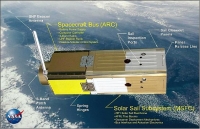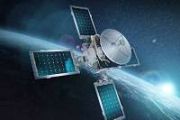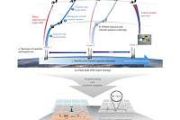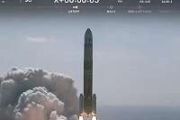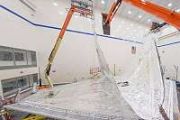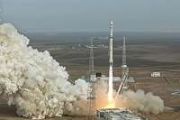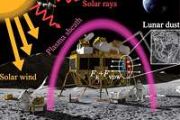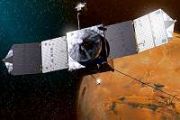NanoSail-D2 is a technology demonstration experiment of NASA with the primary objective to deploy a compact solar sail boom system in space.
In a previous attempt, a team from the NASA/MSFC, along with a team from the NASA/ARC (Ames Research Center), developed a solar sail mission called NanoSail-D which was lost in a launch failure aboard a Falcon 1 rocket on August 3, 2008.
Two units of the NanoSail-D satellites have been built. NASA/MSFC plans to launch the backup NanoSail-D payload from a 3U CubeSat (nanosatellite) of ARC on the FASTSat-HSV mission. FASTSat is required to launch the nanosatellite before the NanoSail-D2 payload can be launched and deployed from the nanosatellite.
NanoSail-D2 consists of a sail subsystem stowed in a 3-element CubeSat. Shortly after deployment of the NanoSail-D2, the solar sail will deploy and mission operations will commence. This demonstration flight has two primary technical objectives: 1) 2) 3) 4) 5)
• To successfully stow and deploy the sail
• To demonstrate deorbit functionality.
Passive attitude stabilization of the spacecraft will be achieved using permanent magnets to detumble and orient the body with the magnetic field lines and then rely on atmospheric drag to passively stabilize the sailcraft in an essentially maximum drag attitude.
NanoSail-D and -D2 team members: NanoSail-D was jointly designed and built by NASA/MSFC and NASA/ARC. ManTech/NeXolve Corporation also provided key sail design support. The NanoSail-D experiment is managed by Marshall and jointly sponsored by the Army Space and Missile Defense Command, the Von Braun Center for Science and Innovation, and Dynetics Inc. Ground operations support was provided by Santa Clara University (SCU), with radio beacon packets received from amateur operators around the world. 6)
Solar sail propulsion fundamentals:
Solar sail propulsion utilizes the solar radiation pressure exerted by the momentum transfer of reflected light. The integrated effect of a large number of photons is required to generate an appreciable momentum transfer. Therefore, a large sail area is needed. And since acceleration is inversely proportional to mass for a given thrust force, the mass of the sailcraft must be kept to a minimum.
Figure 1 illustrates how the solar radiation pressure is utilized for propulsion. Incident rays of sunlight reflect off the solar sail at an angle θ with respect to the sail normal direction. Assuming specular reflection from a perfectly flat sail membrane, there will be two components of force: one in the direction of the incident sunlight, and the second in the direction normal to the incident rays. When the force vectors are summed, the components tangent to the sail surface cancel and the components normal to the surface add to produce the thrust force in the direction normal to the sail surface. For the perfect 40 m x 40 m square sail at 1AU (Astronomical Unit) from the sun, the solar radiation thrust force is ~0.03 N.
Figure 1: Solar radiation thrust force (image credit: NASA/MSFC)
Spacecraft:
The stowed configuration of the NanoSail-D2 spacecraft is illustrated in Figures 2 and 3. The spacecraft bus, provided by ARC, is configured with a flight-proven computer, power supply, S-band radio and UHF beacon radio. Permanent bar magnets that are installed in the bus closeout panels provided passive attitude control. The spacecraft bus occupies the upper 1/3 volume of the 3U sized “CubeSat” class spacecraft.
Figure 2: On-orbit view of the NanoSail-D2 spacecraft before sail deployment (image credit: NASA/ARC)
Figure 3: View of the triple CubeSat containing the NanoSail-D2 payload (image credit: NASA)
NanoSail-D2 is a passenger payload mounted in its P-POD on top of the FASTSat-HSV minisatellite. In turn, FASTREC-HSV is a passenger payload on the STP-S26 multi-payload mission of the USAF (United States Air Force).
The solar sail subsystem occupies the lower 2/3 volume of the spacecraft. Sail closeout panels provide protection for the sail and booms during the launch phase of the mission. These panels have spring loaded hinges that will be released on-orbit, under the command of the spacecraft bus. Figure 5 depicts the NanoSail-D on-orbit after closeout panel release, prior to the sail deployment.
Figure 4: Illustration of the NanoSail-D payload in the triple CubeSat (image credit: NASA) 7)
Figure 5: Panel deployed configuration of NanoSail-D (image credit: NASA)
Figure 6: Illustration of the FASTSat host spacecraft with the NanoSail-D2 payload on top in a P-POD (image credit: NASA)
Launch: The FASTSat-HSV minisatellite was launched as a secondary payload on Nov. 20, 2010 (UTC, the local date of the launch was Nov. 19, 2010) from Kodiak Island, Alaska, on a Minotaur-4-HAPS (Hydrazine Auxiliary Propulsion System) expandable launch vehicle of OSC. The primary payload of this mission, known as STP-S26, is STPSat-2 (Space Test Program Satellite-2) of DoD, the first satellite based on the STP-SIV (Standard Interface Vehicle). The HAPS capability of precise orbit insertion permits the deployment of small payloads into dual orbits. 8) 9) 10)
Orbit: Circular orbit, altitude = 640 km, inclination = 72º, with an orbital period of 97.7 minutes.
Figure 7: A pictorial of the original planned timeline of the NanoSail-D2 mission (image credit: NASA)
Mission status:
• NanoSail-D2 orbited the Earth for 240 days performing well beyond expectations and burned up during reentry to Earth's atmosphere on Sept. 17, 2011. NanoSail-D2, a nanosatellite that deployed NASA's first-ever solar sail in low-Earth orbit, has successfully completed its Earth orbiting mission. 11)
Figure 8: Orbital profile of the NanoSail-D2 mission (image credit: NASA)
The flight phase of the mission successfully demonstrated a deorbit capability that could potentially be used to bring down decommissioned satellites and space debris by re-entering and totally burning up in the Earth's atmosphere. The team continues to analyze the orbital data to determine how future satellites can use this new technology. - A main objective of the NanoSail-D mission was to demonstrate and test the deorbiting capabilities of a large low mass high surface area sail.
• As of summer 2011, NanoSat-D2 continues to orbit the Earth and is slowly decreasing in altitude. There have been many NanoSail-D2 observations from people around the world as the satellite treks across the dark sky. Mr. R. Vandebergh in the Netherlands captured what is believed to be the first picture of NanoSail-D2 from the ground (Ref. 13).
Figure 9: NanoSail-D2 photo from the ground (image credit: R. Vandebergh)
• On March 2, 2011, NanoSail-D2 was caught on video: Robert Suggs of MSFC used the Automated Lunar and Meteor Observatory at Marshall Space Flight Center to catch NanoSail-D2 on video as it slipped across the sky back on March 2, 2011. This video is from the small finder camera for the observatory and the solar sail appears just how it would be seen by the the naked eye. 12)
• NASA's nanosatellite NanoSail-D2 is slowly descending after successfully orbiting the Earth's upper atmosphere for 95 days since deploying its sail on Jan. 20, 2011. The small satellite demonstration experiment continues its descent towards Earth, lending key sail data to the design of de-orbit mechanisms for future satellites. 13)
NanoSail-D2 has lowered its altitude above the Earth by approximately 45 km from its original altitude of 640 km and continues to descend. Prior to launch, NASA's original de-orbit analysis was based on a maximum drag attitude, which meant NanoSail-D2 would de-orbit in 70-120 days. Based upon NASA's current analytical assessments of the NanoSail-D2 tracking data, the team predicts NanoSail-D2 will continue to descend and eventually re-enter Earth's atmosphere and disintegrate six months to one year from sail deployment (Ref. 13).
• After the sail unfurling event of NanoSail-D2, NASA formed a partnership with Spaceweather.com to engage the amateur astronomy community to submit the best images of the orbiting NanoSail-D2 solar sail. 14) 15)
• NanoSail-D2 continued sending data for only a short time afterwards. Its onboard batteries expired in only 12-24 hours after the sail deployed. The entire free flying powered lifetime of the satellite was less than 100 hours. From ejection to loss of power, the mission control team at SCU received 469 data packets via the amateur radio community from 11 different countries. Mission data was displayed on the NanoSail-D Dashboard (Ref. 6).
• Since NanoSail-D2 ejected on Jan. 17, it was due to unfurl its sail 28 hours later. The team quickly notified the NanoSail-D2 MOC (Mission Control Center) at SCU. SCU would send the backup deploy command in the event that the onboard timer system failed to operate (Ref. 6).
As the time approached (on January 20), NanoSail-D2 would be tracking right over Europe when the sail was timed to unfurl. In the Netherlands, another amateur radio operator, Henk Hamoen (PA3GUO) was anxiously awaiting the beacon transmissions. The beacon data would change right after the sail deploy event to indicate success. Mr. Hamoen received and recorded the data from the pass, but unfortunately, he missed recording the deployment event. As the NanoSail-D satellite passed out of range, Mr. Hamoen could still hear the beacon transmitting.
As NanoSail-D2 continued to track on its orbital path there would be very little chance for someone to receive the data right away. It was late at night in the United States and the satellite was going over the South Pacific. Very few amateur operators were available in that region. In Inuvik, Northwest Territories, Canada a couple of amateur operators were following the progress of NanoSail-D2 on its Twitter feed. John Boudreau, VE8EV, and Nelson Eisel, VE8NE, were waiting for their turn to receive and decode NanoSail-D2’s signal. As the satellite tracked over Northern Canada, Mr. Boudreau and Mr. Eisel were actively listening and ready to decode the beacon signal. They captured the signal and translated the data for two successive beacon transmissions. The data sets were relayed to SCU mission control and the NanoSail-D team in Huntsville. Both teams verified the data as authentic and the data indicated the sail had deployed.
On the following day (January 21), JSpOC operators confirmed what the team had expected. The sail had indeed unfurled (January 20, 2011). The NanoSail-D mission had accomplished its goal of deploying a sail in low-Earth orbit. NanoSail-D2 had done it!
Although NanoSail-D2 was not the first to deploy a sail in space, that honor belongs to JAXA’s IKAROS mission; it was to be the first sail vehicle to orbit the Earth (Ref. 6).
• On Jan. 19, 2011, engineers at MSFC (Marshall Space Flight Center) in Huntsville, AL, confirmed that the NanoSail-D2 nanosatellite ejected from FASTSAT (Fast Affordable Scientific and Technology Satellite). The ejection event occurred spontaneously and was identified on Jan. 17 when engineers at the center analyzed onboard FASTSAT telemetry. The ejection of NanoSail-D2 also has been confirmed by ground-based satellite tracking assets. 16)
- On Jan. 18, 2011, the FASTSAT MOC at MSFC had trouble initially contacting the satellite and finally downloaded the data from the previous weekend. The team noticed an anomaly had occurred and started to investigate the problem. Solar panel voltage and current sensor data was different that from any previous timeframe. The analysis suggested that the satellite experienced a sudden spinning and then gradual slowing of the spacecraft. This was the exact condition that the spacecraft would have experienced after ejection of NanoSail-D2 (Ref. 6).
- A call to JSpOC the next day confirmed the team’s hypothesis. There was another object being tracked in the orbital path of FASTSAT. The JSpOC operator indicated that the object had separated from the FASTSAT satellite at approximately the same time as the anomaly occurred on January 17th (Ref. 6).
- Amateur ham operators were asked to listen for the signal to verify NanoSail-D2 is operating.
• The NanoSail-D2 ejected on January 17 (UTC). Beacon data was routinely received by the public throughout the world (amateur radio community) from Jan. 19-21, 2011, and the telemetry indicated that the sail deployed on schedule. 17) 18)
- January 17th, 2011 was the Martin Luther King Jr. holiday and both the FASTSAT and NanoSail-D2 team members were off from work. The FASTSAT satellite had been placed in an unattended operational configuration. This configuration allows the operators to take time off while the spacecraft operates autonomously (Ref. 6).
- Unknown to everyone, something was happening in space: NanoSail-D2 was in the process of freeing itself from its restraints. That evening, at approximately 21:00 CST, NanoSail-D2 shot away from FASTSAT (Ref. 6).
- For 42 days after it was commanded to eject, NanoSail-D2 was actually stuck in its mothership, FASTSAT. Team members began to give up hope as weeks went by and NanoSail-D2 remained stubbornly and inexplicably onboard. The mission seemed to be over before it even began. And then came Jan. 17, 2011. For reasons engineers still don't fully understand, NanoSail-D2 spontaneously ejected itself. 19)
• On Dec. 10, 2010, NASA reported : It is not clear that NanoSail-D2 ejected from the FASTSAT as originally stated on Monday, Dec. 6. At the time of ejection, spacecraft telemetry data showed a positive ejection as reflected by confirmation of several of the planned on orbit ejection sequence events. The FASTSAT spacecraft ejection system data was also indicative of an ejection event. NanoSail-D was scheduled to unfurl on Dec. 9 at 12:30 a.m., and deployment hasn't been confirmed. The FASTSAT team is continuing to trouble shoot the inability to make contact with NanoSail-D. The FASTSAT microsatellite and all remaining five onboard experiments continue to operate as planned. 20)
• The JSpOC (Joint Space Operations Center) was also monitoring the event. JSpOC is responsible for tracking all objects in space and was highly interested in the ejection of NanoSail-D2 from FASTSAT. The next day (Dec. 9) , the NanoSail-D2 team asked the JSpOC if any new object had been located in the FASTSAT orbital path. Their reply was negative. This confirmed that NanoSail-D2 was stuck somehow inside the P-POD (Ref. 6).
• On Dec. 6, 2010, the command was given to start the NanoSail-D2 ejection sequence. The ejection event had to occur in a specific timing window to allow the SCU mission control in California to have multiple communication opportunities with NanoSail-D2 (Ref. 6).
- NASA for the first time “successfully ejected a nanosatellite” from a free-flying microsatellite (however, this statement didn't turn out to be true). NanoSail-D ejected from the FASTSAT, demonstrating the capability to deploy a small CubeSat payload from an autonomous microsatellite in space. 21)
• Shortly after launch, FASTSAT verified its systems and scientific payloads were in good condition. In about seven to ten days, all the FASTSAT systems were confirmed to be operational.
NanoSail-D2 experiment:
The NanoSail-D2 experiment has two major components:
• Bus electronics: The electronic system on the sail, responsible for deployment and communication, was provided by Ames Research Center. The electronic box is roughly 9.8 cm x 9.8 cm in size.
• Sail subsystem: The sail is made of an ultra-thin reflective polymer called CP-1. It is 7.5 µm thick and has a deployed surface area of 10 m2. The sail is wound tightly around a central hub. When the sail deploys, four booms spring out to unfurl the sail and support its structure. The booms are each 2.25 m long when fully deployed. The 4.2 kg sail subsystem was provided by ManTech/NeXolve in Huntsville, AL.
The sail uses eight lithium-ion batteries as a power source. The solar sail subsystem occupies the lower 2/3 volume of the spacecraft. Sail closeout panels provide protection for the sail and booms during the launch phase of the mission. These panels have spring-loaded hinges that will be released on-orbit, under the command of the spacecraft bus. Figure 11 shows the fully deployed NanoSail-D2 in a ground test.
Figure 10: Structure of deployed sail configuration (image credit: NASA)
Figure 11: NanoSail-D2 ground deployment test (image credit: NASA/MSFC)
The sail subsystem is divided into two primary components—the sail assembly and the boom mechanical assembly. Once assembled, the sail subassembly consists of a standalone unit that is bolted to the bus and connected to the release electronics.
The launch operations consist of a simple, timed two-actuation system. The initiating event consists of a burn-wire release of the door panels. The door panels protect the sail material and help to constrain it for the launch environment and ascent venting. The sail membranes, fabricated from aluminum coated CP1™ material used originally in the ATK Solar Sail Ground Demonstration Project, are z-folded and rolled onto a sail spool. The TRAC (Triangular Rollable and Collapsible) booms, developed by the U.S. AFRL (Air Force Research Laboratory), are also rolled onto a boom spool. The stored strain energy of the rolled booms provides the driving force to simultaneously deploy both the booms and the sail quadrants. 22)
Several boom deployment tests were executed and the system performed as expected.
Figure 12: Photo of the AFRL TRAC boom sample (NASA)
NanoSail-D2 will be ejected from the FASTSAT spacecraft bus seven days after launch.
After ejection from the container, an internal timer will start counting down. The sail is tightly wound around a spindle and packed in a small container. When the timer reaches zero, the four panels covering the sail and booms will open. Approximately 30-45 seconds later, four booms will spring out and NanoSail-D2 will start to unfold. Within just five seconds the sail will be fully deployed.
Figure 13: Artist's view of the deployed NanoSail-D2 spacecraft (image credit: NASA)
The entire NanoSail-D2 mission duration will be between 70 and 120 days, depending on how quickly the sail falls out of orbit. 23)
1) Les Johnson, Roy Young, Edward Montgomery, Dean Alhorn, “Status of the Solar Sail Technology within NASA,” Proceedings of the Second International Symposium on Solar Sailing, New York, NY, July 20-22, 2010, URL: undefined
3) “Factsheet NanoSail-D,” URL: undefined
4) D. C. Alhorn, J. M. Scheierl, “Feathersail - Design, Development and Future Impact,” URL: undefined
5) Les Johnson, Mark Whorton, Andy Heaton, Robin Pinson, Greg Laue, Charles Adams, “NanoSail-D: Solar Sail Demonstration Mission,” Sixth IAA Symposium on Realistic Near-Term Advanced Scientific Sapce Missions, Aosta, Italy, July 6-9, 2009, URL: undefined
6) Dean C. Alhorn, Joseph P. Casas, Elwood F. Agasid, Charles L. Adams, Greg Laue, Christopher Kitts, Sue O'Brien, “NanoSail-D: The Small Satellite That Could!,” Proceedings of the 25th Annual AIAA/USU Conference on Small Satellites, Logan, UT, USA, Aug. 8-11, 2011, paper: SSC11-VI-1
7) E. E. Montgomery, C. L. Adams, “NanoSail-D,” CubeSat Developers' Workshop, San Luis Obispo, CA, USA, April 9-11, 2008, URL: undefined
8) “Orbital Minotaur IV launches with multiple satellites,” URL: undefined
9) Dan Belden, “Space Test Program - Access to Space Road-show,” URL: undefined
10) “FastSat Ready for Shipping to Alaska,” NASA, June 7, 2010, URL: undefined
11) “NASA's Nanosail-D 'Sails' Home -- Mission Complete,” NASA, Nov. 29, 2011, URL: undefined
12) “NanoSail-D Caught on Video,” NASA, May 11, 2011, URL: undefined
13) “NASA's NanoSail-D Satellite Continues to Slowly De-Orbit Earth's Upper Atmosphere,” NASA/MSFC, April 26, 2011, URL: undefined
14) Steve Cole, Kim Newton, “NASA Partners On NanoSail-D Amateur Astronomy Image Contest,” NASA release: 11-027, Jan. 24, 2011, URL: undefined
16) Kim Newton, “NanoSail-D Ejects: NASA Seeks Amateur Radio Operators' Aid to Listen for Beacon Signal,” NASA/MSFC, Jan. 19, 2011, URL: undefined
17) “NanoSail-D2 Mission Dashboard,” URL: undefined
18) “NASA's First Solar Sail NanoSail-D Deploys in Low-Earth Orbit,” NASA, Jan. 21, 2011, URL: undefined
19) Tony Phillips, “Solar Sail Stunner,” NASA, January 24, 2011, URL: undefined
20) “NanoSail-D Mission Status Update for Dec. 10,” Planetary Society, Dec. 10, 2010, URL: undefined
21) “NASA Ejects Nanosatellite From Microsatellite in Space,” Dec. 6, 2010, URL: undefined
22) Jeremy A. Banik, Thomas W. Murphey, “Performance Validation of the Triangular Rollable and Collapsible Mast,” Proceedings of the 24th Annual AIAA/USU Conference on Small Satellites, Logan, UT, USA, Aug. 9-12, 2010, SSC10-II-1
23) D.C. Alhorn, “Feathersail - the next generation of nano-class sail vehicle,” URL: undefined
The information compiled and edited in this article was provided by Herbert J. Kramer from his documentation of: ”Observation of the Earth and Its Environment: Survey of Missions and Sensors” (Springer Verlag) as well as many other sources after the publication of the 4th edition in 2002. - Comments and corrections to this article are always welcome for further updates.

